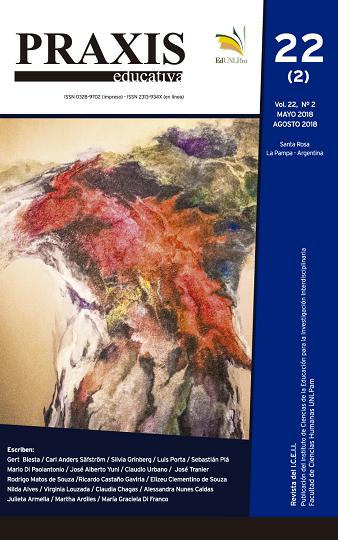Polyphonic manifestations of pedagogy: Epilog(s) that interrupt sense(s)
DOI:
https://doi.org/10.19137/praxiseducativa-2018-220213Keywords:
pedagogy, future, condition, interrupt, schooling crisisAbstract
We propose four irruptions as an epilogue, they seek tensions and meanings in relation to the task of education and pedagogy that, as a conceptual record, offers us lines to inhabit and think about the world in which we live, but also the one we would like to live. Multiple claims and recipes resonate for education in the digital age. Since the end of the last century, education policies have moved between two vertices: crisis and reforms. Reforms of schooling that have been launched in the most diverse countries and regions that make up the globalized world promising answers to this question. It is in this climate of time that Biesta and Säfström propose their manifesto for education where, as they point out, moving between what is and what is not, has become the crossroads for contemporary schooling. Probably, this image is one of the most global in the globalized world. Of course, its effects and local affections are multiple and diverse. This dossier is installed there: to inhabit the educational word, to ask about it. This calls for the imperative need to be manifested by education in a way that allows us to escape a duality that has done nothing but undermine the school without offering lines with which to weave other plots. Interrupting is also the challenge for a theory of education that tries to escape to the crossroads by staying in tension, destabilizing the future by recognizing its openness, opening the possibility to different future potentials.
Downloads
References
Arendt, H. (1996a) La condición humana. Paidos, Buenos, México, Madrid.
Arendt, H. (1996) Entre el pasado y el futuro. Ocho ejercicios sobre la reflexión política. Ediciones península, España.
Arendt, H. (2001b) Eichmann en Jerusalem. Un estudio sobre la banalidad del mal. Lumen editorial, España.
Coccia, E. (2011) La vida sensible, Buenos Aires: Marea.
Colombani, C. (2014). La construcción del “entre” en el espacio educativo. En Revista Entramados. Educación y sociedad, de la Universidad Nacional de Mar del Plata, Año 1, Nº 1, 2014. pp. 137-144.
Day, C. (2006) Pasión por enseñar, Barcelona: Narcea.
Derrida, J. (1998) Adios a Levinas, Madrid: Editorial Trota.
Grinberg, S. (2008) Educación y poder en el siglo XXI. Buenos Aires: Miño y Dávila.
Grinberg, S. (2011) “La conjura del ADN”. En, AA.VV., Cuadernos de trabajo Nº1. Biopolítica. Gubernamentalidad, educación, seguridad, UNIPE: Editorial Universitaria, Buenos Aires, pags. 13-24.
Grinberg, S. (2011) “Territories of schooling and schooling territories in contexts of extreme urban poverty in Argentina: Between management and abjection”, Emotion, Space and Society, ISSN: 1755-4586. Elesevier. Netherlandas pags. Volume 4, Issue 3, August 2011, Pages 160–171
Grinberg, S. (2013) “Sociedad de la información, tecnologías y pedagogías de las competencias en la era del management. Hacia una genealogía.” Revista Controversias y Concurrencias Latinoamericanas, Año 5 | Número 8 | Diciembre de 2013, ISSN 2219-1631, 86-97.
Le Breeton, D. (2010) Cuerpo sensible. Bogotá: Metales pesados.
Rose, N. (2007) The politics of life itself. Princeton University Press, Princeton and Oxford, USA.
Porta, L. y Flores, G. (2017) Narratividad e interpretación: nexos entre la investigación narrativa y la hermenéutica, en: Revista Brasileira de Pesquisa Autobiográfica. Salvador, Brasil. ISSN 2525-426X. V 2, Nº 6, p. 683-697. Septiembre-diciembre de 2017.
Rose, N. (2010) “‘Screen and intervene’: governing risky brains”, en, History of the Human Sciences Vol. 23 No. 1 pp. 79–105, UK: Sage publications.
Sooke, A. (2014). “Yves Klein: el hombre que inventó un color azul”, en: Especial para BBC Cultura. https:// almacosta.wordpress.com/2014/09/12/yves-klein-elhombre-que-invento-un-color-azul/. Fecha de consulta: 11/02/2018, 15:33 hs.
Downloads
Published
Issue
Section
License
Copyright Notice
Editorial Committee Educational Praxis Magazine:
I hereby declare that I am the author of the article titled (article name), that it is original and my own and that it was not previously published in any other format or medium. I declare to know that the magazine will not charge me any type of fee under any circumstances, nor will I receive any type of monetary compensation If it were accepted for publication in Educational Praxis, I authorize the aforementioned magazine to publish it digitally and to advertise it on its social networks.
If the work is published, I adhere to the Creative Commons license called "Attribution - Non-Commercial Share Alike CC BY-NC-SA", through which it is allowed to copy, reproduce, distribute, publicly communicate the work and generate derivative works, as long as when the original author is cited and acknowledged. This license has been used since September 2018. In 2016 CC BY NC ND 4.0 was adhered to; and in the years 2017 and 2018 (January-August) CC BY NC 4.0.
This CC BY-NC-SA Share Alike license does not, however, permit commercial use of the work. As an author, the journal may establish additional agreements for the non-exclusive distribution of the version of the work published in the journal, it allows me to self-archive the published articles, in their post-print version, in institutional, thematic repositories, personal web pages or any other relevant use. with the recognition of having been first published in this journal.
Educational Praxis adheres to DORA (Declaration on Research Assessment) signed in San Francisco, California, on December 16, 2012, and to the Declaration of Mexico (Joint Declaration LATINDEX - REDALYC - CLACSO - IBICT).















_(1)2.png)


3.png)











_(2).png)






2.jpg)









